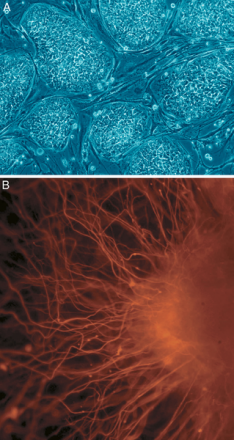How Science is Helping People Help Themselves
An Overview of Stem Cells
All stem cells have two basic characteristics that make them stem cells:
The ability to divide and make copies of themselves indefinitely.
They can be induced to differentiate into more specialized cells. [2]
There are 2 main types of stem cells in the human body:
1. Somatic or "Adult" stem cells: these are found in many locations throughout the adult body.
2. Embryonic stem cells: found in the inner region of ~5 day old babies. More information about embryonic stem cells and culturing.
*There is a special kind of somatic stem cell called an Induced Pluripotent Stem Cell (iPSC). In this kind of cell, an egg cell is injected with DNA from an adult cell. This has the effect of creating an embryonic stem cell with the parent DNA, which carries the advantages of pluripotentcy and having a reduced chance of being rejected by the person's immune system if and when the cells are introduced into the body. [2]
The ability to divide and make copies of themselves indefinitely.
They can be induced to differentiate into more specialized cells. [2]
There are 2 main types of stem cells in the human body:
1. Somatic or "Adult" stem cells: these are found in many locations throughout the adult body.
2. Embryonic stem cells: found in the inner region of ~5 day old babies. More information about embryonic stem cells and culturing.
*There is a special kind of somatic stem cell called an Induced Pluripotent Stem Cell (iPSC). In this kind of cell, an egg cell is injected with DNA from an adult cell. This has the effect of creating an embryonic stem cell with the parent DNA, which carries the advantages of pluripotentcy and having a reduced chance of being rejected by the person's immune system if and when the cells are introduced into the body. [2]
Stem cells can be divided into three categories based on functionality:
Totipotent stem cells can give rise to an entire organism and every specialized cell in the body.
Pluripotent stem cells can differentiate into any specialized cell, but not an entire organism. Embryonic stem cells fall into this category.
Multipotent stem cells can differentiate into a limited number of cells, usually closely related to the organ they came from. [8]
For more information about stem cells:
Stem Cell Culturing
Somatic Stem Cell Locations
Totipotent stem cells can give rise to an entire organism and every specialized cell in the body.
Pluripotent stem cells can differentiate into any specialized cell, but not an entire organism. Embryonic stem cells fall into this category.
Multipotent stem cells can differentiate into a limited number of cells, usually closely related to the organ they came from. [8]
For more information about stem cells:
Stem Cell Culturing
Somatic Stem Cell Locations

